The difficult fate of the Tu-160 (part of 2)
"... Continuation of the merits"
No matter how good the plane turned out to be, trial operation initially yielded a generous harvest of flaws. Almost every flight of the Tu-160 brought failures of various systems and, above all, complex and capricious electronics (the fact that the development of B-1B by the Americans was accompanied by the same difficulties was not very encouraging). Rescued multiple degree of duplication and redundancy (for example, the electrical control system of the bomber has four channels and emergency mechanical wiring).
Especially a lot of trouble was brought by the "raw" BKO, due to the extremely low reliability, which earned a reputation as "ballast", two tons of which were carried with it in vain. After numerous revisions in April, 1990 of the BKO managed to get to work (on the occasion of which A.A. Tupolev came to the regiment), although the refusals pursued him in the future.
The NK-32 engines had problems starting up - the most unstable mode of operation, which the automation couldn't cope with, there were failures in flight (mainly due to a wayward electronic control system, once on the plane of Major Vasin, two engines were turned off in the air). Nevertheless, the stock of thrust allowed the aircraft to continue flying and even take off with one engine inoperative, which was what the US Secretary of Defense F. Carlucci had to use when showing the Tu-160 — both aircraft took off and performed a passage on three engines (naturally, the Minister was not informed ). Resource NK-32 gradually tripled and brought to 750 h. Air intakes turned out to be weak places on the glider, their imperfect gas dynamics caused itching and vibrations, which caused cracks and rivets to fly out. This defect was eliminated by replacing the first sections of the air ducts (they had to be pulled in front “through the throat”) and strengthening the edging of the front edges of the air intake. The kinematics of the main landing gear chassis was too complicated — when the rack was being cleaned, they shortened to fit into small niches, and when they were released, they moved, shifting to the outside and increasing the gauge by 1200 mm. The low reliability of the landing gear-release mechanism made it possible for 1988 to fly for several months without cleaning it, but from the next series, the kinematics were changed, removing the “extra” strut, and all previous airplanes were refined. Improved and hydraulic aircraft.
At high flight speeds, cellular glued panels of the stabilizer were “flapped” and “slammed” (on one of the airplanes in LII, a solid piece of feathering even came off in the air, the same case occurred in the regiment with A. Medvedev). It was necessary to strengthen the plumage, at the same time “cutting” by half a meter to reduce the loads. Modified stabilizers, “oversized cargo” with a span of 13,25 m, delivered from the factory to the part on the fuselage of the special variant IL-76 - “triplane”. During the demonstration in Ryazan, Tu-160 lost in the air one of the plastic fairings forquil (the plane definitely did not like the shows).
These defects, as a rule, did not lead to serious consequences (the trial operation of the new machine was just aimed at their “catching”), and the most unpleasant was the sudden blocking of the brakes on takeoff, once the plane “smashed” outright. There were several cases when, when landing, the pilots underestimated the inertia of a multi-ton machine, and it flew over the ground flying over the ground (no aerofinisher could stop the Tu-160, and it was considered a “low class” in time for a braking parachute).
Revealed failures and defects related to design and production flaws (in the “KPN” column, the developer, the design bureau and the manufacturer) are responsible, were taken into account in the design of the aircraft of the new series. The number of sashes of the engine make-up on the side walls of the air intakes was increased to six to increase the compressor stability margin, they were simplified, their airframes were replaced by composite honeycomb panels with metal filler (this resulted in a gain in weight and resource), the BSE antenna fairing was shortened by half, the GER antennas were tailored flow from which at high speeds caused dangerous vibrations, disabling equipment. On the aircraft of the latest series, the upper hatches of the navigator and operator were equipped with periscopes for inspecting the tail hemisphere (in addition to the rear-view radar). In the same way, previously released by the Tu-160 factory specialists were directly upgraded to the regiment.
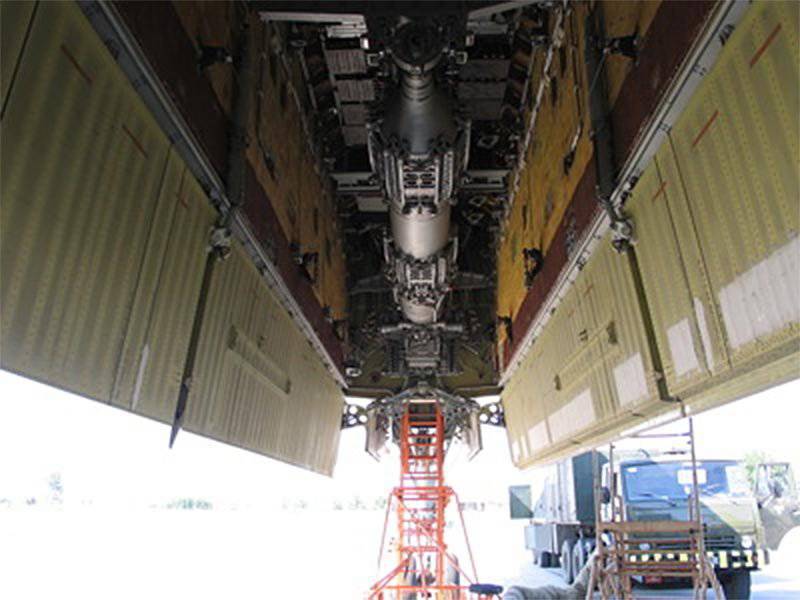
Modernized and equipment aircraft. Improved RSDN, guided by ground radio beacons. The navigation complex was equipped with an autonomous astrocorrector, which determines the coordinates of the machine for the Sun and the stars with high accuracy, which was especially useful in flights over the ocean and in high latitudes. Approval of the navigators received a PA-3 course cursor with a movable map indicating the current position of the aircraft. For the Tu-160, the on-board satellite navigation system was also prepared with the accuracy of determining the 10-20 coordinates. Its operation was ensured by several orbiters specially launched into space as part of the state program for the needs of the Air Force, Navy and Ground Forces. It was possible to solve the problems associated with software and systems engineering PRNK (previously all of its four channels "spoke" in different languages).
In several stages, a set of measures to reduce the radar visibility of the Tu-160 was carried out: black air absorbing graphite plaster was applied to the air intakes and canals to the engines, the nose was covered with organic paint on an organic basis, and the secret of this development was still strictly hiding).
Mesh filters were inserted into the cabin's glazing, which “locked” the electromagnetic background of the equipment inside, which could unmask the aircraft. Filters should also weaken the luminous flux at a close nuclear explosion (with the same purpose, the glass is equipped with curtains and blinds), and the ZSh-7AC helmet light filter can protect pilots' eyes from a blinding flash.
Presentations
2 August 1988. US Secretary of Defense Frank Carlucci was the first foreigner to see the Tu-160. At the Moscow Kubinka airbase near Moscow, he was shown an 184-th regiment with the number 12, and the other two - in flight. At the same time, some tactical-technical characteristics of the aircraft were publicly announced for the first time, including the flight range without refueling, equal to 14000 km. 13 June 1989. Again, in Kubinka, Admiral U. Krau, the chairman of the US Joint Chiefs of Staff, was shown a Priluki Tu-160 with the number 21.
The first airborne meeting of the Tu-160 with Western aircraft occurred in May 1991. over the Norwegian Sea. The F-16A 331 th fighters of the Norwegian Air Force at the latitude of the city of Tromso met and accompanied a couple of Tupolev bombers for a while.
The first public display of the aircraft took place on August 20, 1989 during the celebration of the Day aviationwhen the Tu-160 was at low altitude over the Tushino airfield. In September 1994, journalists and aviation professionals had the opportunity to familiarize themselves in detail with a bomber in Poltava during events to celebrate the 50th anniversary of shuttle raids on Germany, and in Priluki in February 1995.
Airplane for pilots
Tu-160 was perhaps the first Soviet combat aircraft, the creation of which was given due attention to ergonomics. Finally, the demands of the pilots who had previously made up with limited visibility from the cockpit of the Tu-22 (deservedly called “Blind Jack”) and spent long hours in the “tight packing” of the Tu-22M were heard. On long flights, the crew of the Tu-160, having left workplaces, can warm up and rest, even on the foam mattress stretched in the aisle between the navigator’s seats. Amenities include a cupboard for reheating food and a toilet, replacing the "filthy bucket", which were content with the Tu-95. A real battle broke out around the toilet: For several months, the Air Force refused to take the aircraft into service because of its inconsistency with the TTZ (polyethylene bags were used in the toilet after being used; claims were to an insidious device that gave a leaky seam). The customer, having felt his rights, began to show unprecedented principles, and the Commander-in-Chief of the Air Force even threatened to appeal to the military prosecutor’s office if these shortcomings were not eliminated.
At the first production Tu-160, there were complaints about the working conditions of the crew. So, the main and duplicate devices were of various types; the pressure in the cabin was maintained at atmospheric 5000 m (the crew had to be in oxygen masks all the time). Now almost on all machines, these deficiencies are eliminated.
The pilots quickly accustomed to such an unusual element for a heavy machine, like a handle, and not the steering wheel. At first, this innovation did not arouse much enthusiasm among the military. But it soon became clear that the new pen easily, without much physical effort allows you to control the aircraft. The designers also created a version of the pilot's cabin with new equipment, but the transition to it requires modernization of the fleet, time, and most importantly, funds. Therefore, the Tu-160 continue to fly with the old cabin.
Grievances caused a rapid failure of the adjustment mechanisms of the pilots' seats, which forced to modify their electric drive. The ejection seats of K-36DM in the first months of operation themselves had limitations on use (speed not less than 75 km / h). Then their developer, the Zvezda plant (General Designer G.I. Severin), expanded the range, and the ejection became possible even in the parking lot. Chairs equipped with a system of belt tightening, triggered when overloads. In the course of finishing work, the aircraft was tested in a situation that simulates a flight with partial leaving by its crew: the pilot N.Sh. Sattarov went on supersonic on an aircraft with the cabin’s upper hatches dismantled.
Crew claims cause fighter jets and little suitable for long flights overalls, helmets, oxygen masks. On the basis of the regiment, several conferences on the "human factor" were held, at which samples of new equipment were presented: light and comfortable helmets, headphones, rescue overalls "Cormorant", even massagers and expanders that help relieve tension during a long flight. Alas, they all remained in the prototypes. Only on the last series of aircraft appeared built-in ladder, without which at a foreign airfield, the crew could well be literally in a stalemate.
The operational suitability of the Tu-160 also did not go unnoticed by the designers. To facilitate access, the units and the piping of the hydraulic systems were carried to the walls of the cargo compartment, and the switchboards into the chassis niches. Good access to the engines ensured their almost complete “unzipping”. Conveniently assembled shelves with equipment in the cabin and the technical compartment. And yet, the plane turned out to be quite laborious to maintain, becoming a record holder by this criterion — for every hour of the Tu-160 flight, it was necessary to spend 64 man-hours of work on the ground. Preparing it for departure requires 15-20 special vehicles with operating systems, including: installations for the nitriding of fuel; KAMAZ-conditioners, cooling equipment; various tankers, among which are three huge “Hurricanes” TZ-60 (TU-160 tanks contain 171000 kg of fuel); minibus for the crew, equipped with a system of ventilation of high-altitude suits. At the same time, the noise in the aircraft's service area repeatedly exceeds all permissible norms, reaching 130 dB (when the VSU is started up, it exceeds the pain threshold on 45 dB). The situation is aggravated by the lack of headphones, special shoes and anti-vibration belts for technicians. Problems are added by the use of caustic working fluid 7-50С-3 in the hydraulic system.
To reduce noise on the ground, the OKB proposed the same measures that were taken by the Americans for B-1В - the construction of special platforms with built-in concrete maintenance complexes, power supplies and fueling stations. However, the Air Force rejected such an option as non-responsive mobility during the redeployment and only partially accepted it: in the caponiers surrounding the parking areas, shelters were equipped with the ground crew, weapons, tools and equipment for servicing the aircraft.
Continuous work on fine-tuning the Tu-160 gave good results. In terms of reliability, the plane went around even the Tu-16 and was significantly ahead of the Tu-22М2 / М3.
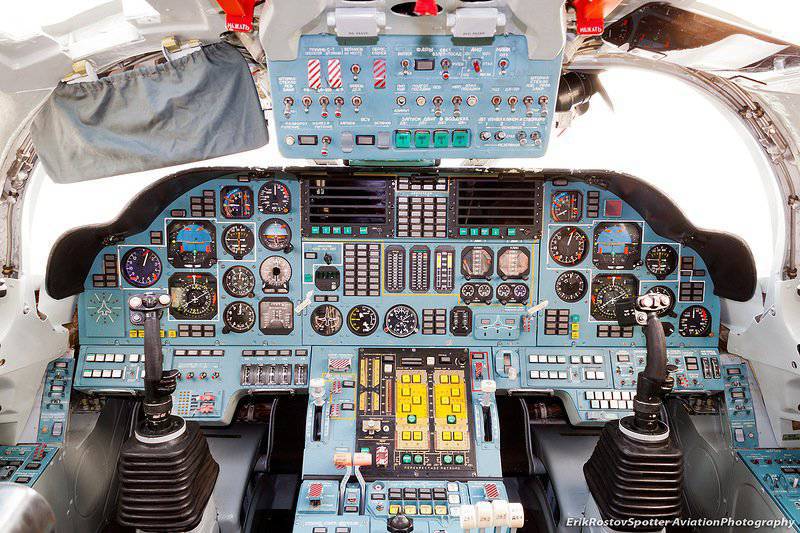
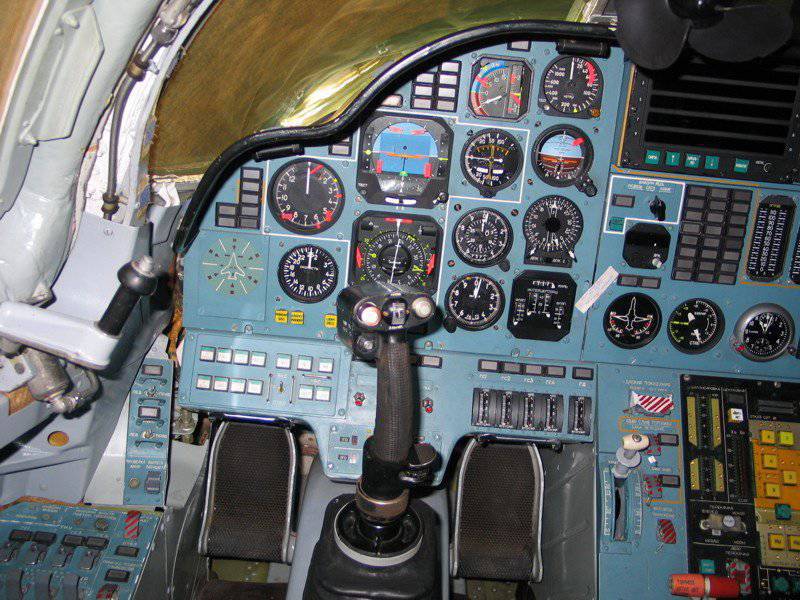
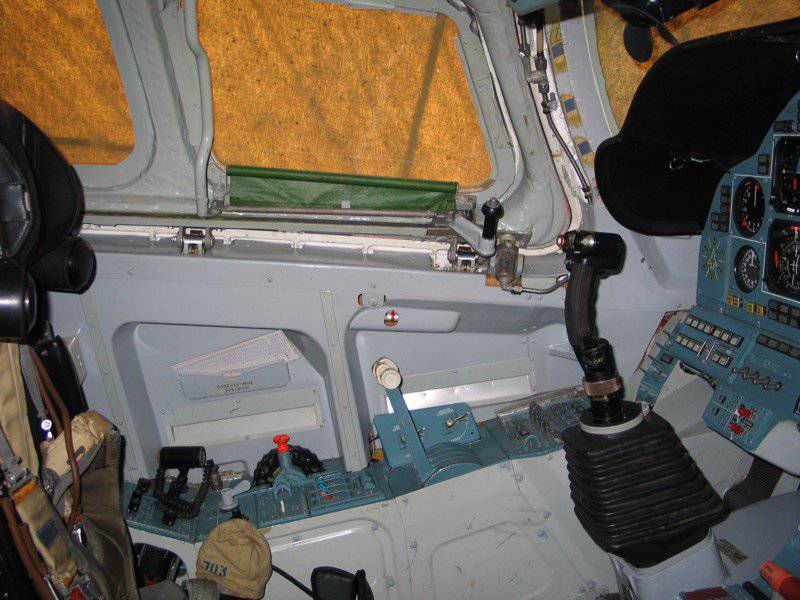
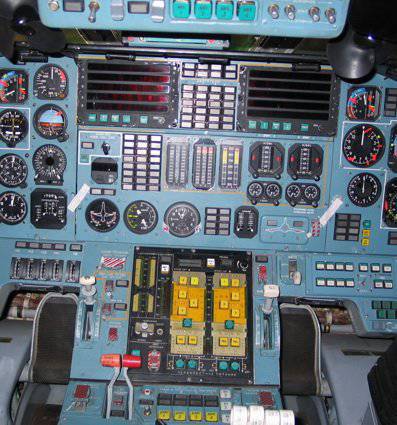
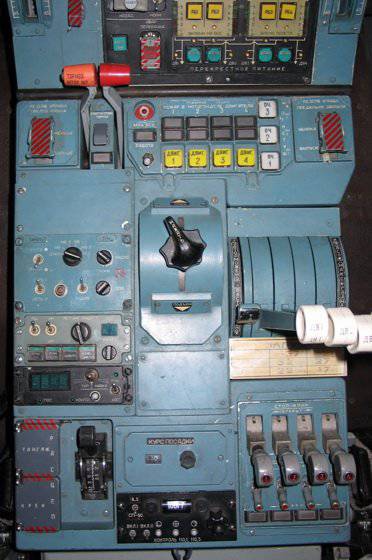
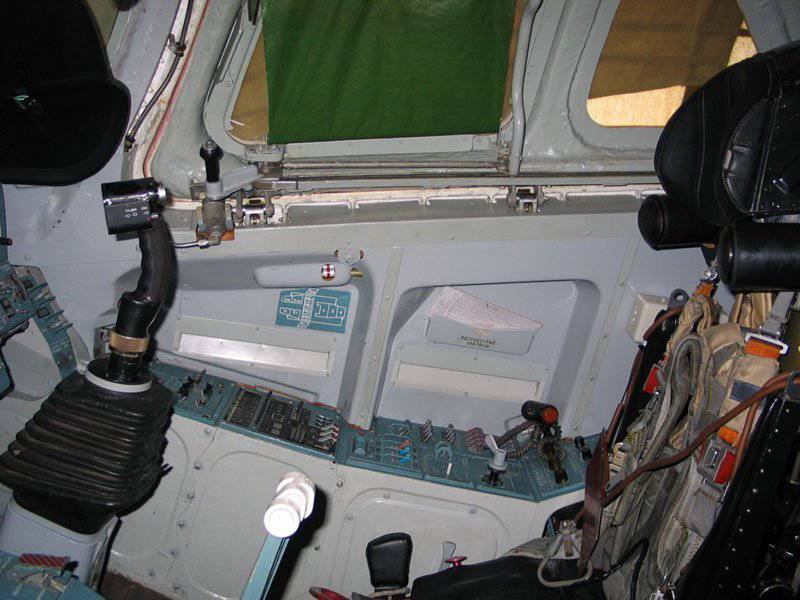
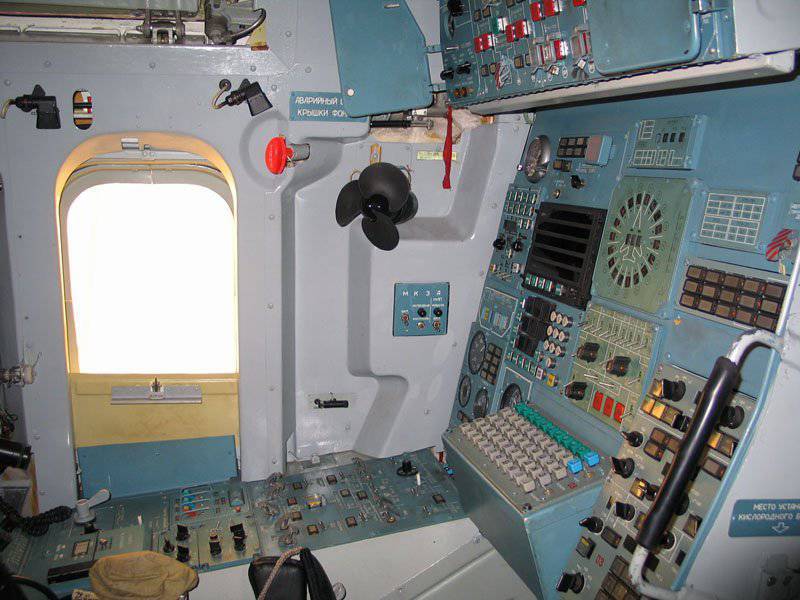
Ahead of the pilots were flying at extremely low altitudes, refueling in the air, which were to provide the bomber intercontinental range (Kozlov, by then, Lieutenant-General, was going to fly on this machine flying around the globe). It was necessary to modernize the PrNK, to master the X-15 missile system and bomber weapons. However, political cataclysms made their adjustments to the fate of the aircraft.
Tu-160 and B-1: similarities and differences
It has already become a tradition, speaking of the Tu-160, to compare it with the American "opponent" - the strategic bomber B-1. Indeed, the similarity of these machines of the same purpose and class, noticeable even to a non-professional, at one time led to the fact that Tu-160 (without knowing its true name) was called "Soviet B-1". The fact that the creators of both aircraft agreed on the “aviation mode” for cars of this class, which included elements of an integral layout and a variable sweep wing, is not surprising. After all, “similar thoughts come to good heads,” and the similarity of the requirements of technical assignments for new bombers at a close scientific and industrial level will inevitably lead to similar design solutions.
But the realization of the conceived, accompanied by an innumerable number of evaluated options, leaves only the proximity of the outer lines to the former similarity. The creators of the aircraft have to rely not only on the uniform laws of aerodynamics and strength for all, but also, increasingly, on the existing production base, the level of technology, their own experience and, finally, the traditions of the company. The political problems on which the financing of the work depends (and often the fate of the project) also affect the “internal content” and possibilities of the future aircraft.
As a brief note, recall: B-1 appeared earlier and made the first flight of 23 December 1974. 30 June 1977. President J. Carter ordered to freeze work on the aircraft, and release the released funds to the development of cruise missiles. Soon it turned out that the optimal relationship between these types of weapons. In November, 1979 began the conversion of B-1 into the carrier of B-1 B cruise missiles, with a simultaneous decrease in its radar visibility when cutting funds for the program. The military and “senators from industry” did not manage to defend many expensive “excesses”, and in the design of the bomber it was necessary to reduce the share of titanium alloys and abandon adjustable air intakes, which reduced the maximum speed to M = 1,25. The aircraft’s armament should have been composed of ALCM cruise missiles, SRAM short-range missiles and nuclear bombs. 23 March 1983 launched the first prototype of the B-1 B (reworked second prototype of the B-1), and the first production aircraft circled 18 in October 1984. Production of the B-1В ended in 1988 with the release of the 100-th bomber.
The Seventies, which was created in a planned economy and did not know the financing problems, went into production and was put into service in the planned form (of course, as amended by the technological level of the aviation industry) - like a multi-mode aircraft capable of delivering intercontinental strikes in a wide range of heights and speeds.
The opportunity to really compare both planes presented itself 23-25 September 1994 in Poltava, where the Tu-160 and B-1В, first met face to face, arrived at the celebration of the 50 anniversary of Operation Francique - shuttle flights of American bombers on target in Germany, which were performed with landing on Soviet airfields. The pilots and technicians of both machines were able to inspect the aircraft, go inside and evaluate in the air, get an idea of their practical capabilities.
The Americans (the group included, in addition to B-1B, the bomber B-52H and tanker KS-10А from the 2-th bomber wing from the Barksdale base in Louisiana) "showed themselves" immediately after crossing the border - if this turn is appropriate here, since the group is disappeared from the screens of ground-based radars (although this incident should not be attributed to the achievements of the stealth technology, but rather to the current state of Ukraine’s air defense). B-1B, which appeared over Poltava, did not waste time on the usual “box” around the airfield, immediately after a sharp turn vigorously dived down (already on the ground, its crew talked about working out maneuvers with rolls up to 45 degrees) - this approach was used to save fuel and categorically unacceptable for our pilots, constrained by a variety of instructions, instructions and safety regulations.
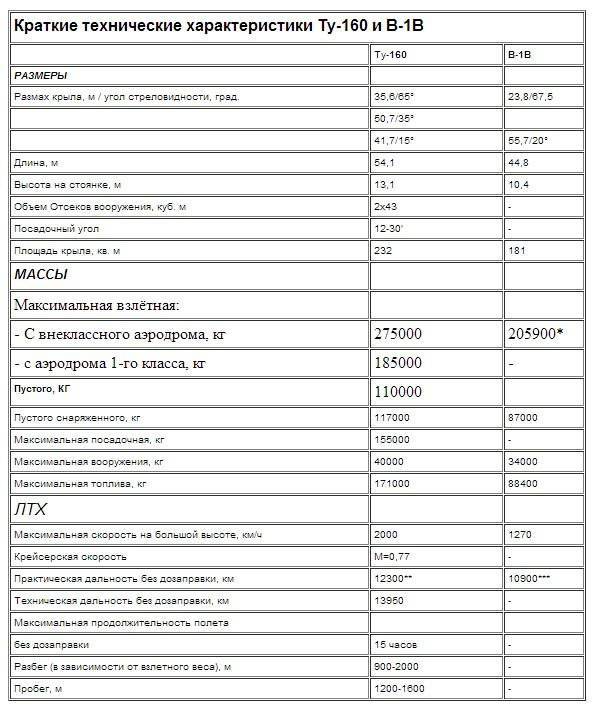
* The maximum allowable take-off weight of 216370 kg, however, information on the operation of the bomber with such take-off weight was not received.
** M = 0,77, 5% fuel reserve, six X-55М missiles fired in the middle of the route.
*** With weapons, consisting of eight UR AGM-64 SRAM, eight nuclear bombs M-61 and PTB on 9000 kg of fuel in the third bomb bay
With closer acquaintance, it turned out that the level of reliability and the number of failures in the operation of the Tu-160 and B-1 B are almost the same. The problems turned out to be similar - frequent engine failures (the B-1 B crew at the Le Bourget exhibition, having failed to launch them, had to abandon the demonstration flight) and the whims of complex electronics, especially the BKO (the Americans did not hide their special interest in “Baikal ":" Does it really work for you? "). It was the lack of reliability of the power plant and onboard EW equipment AN / ALQ-161 and ALQ-153 that prevented the use of B-1 B in Operation Desert Storm, and the laurels went to B-52 veterans.
Regarding offensive weapons, the Tu-160 was "on horseback" - its main weaponcruise missiles were well mastered, while for financial reasons the Americans could not re-equip their aircraft (the expensive ALCM strike complex required not only modifications of cargo compartments, but also a significant change in on-board electronics). The SRAM short-range missiles, taken as a “temporary measure,” developed storage periods for 1994 (solid fuel from their engines began to decompose, losing their properties) and were removed from service, and their replacement remains a matter of the future. Only the B1 and B61 nuclear bombs remained in service with the B-83B; Americans remembered the possibility of equipping the aircraft with conventional bomb armaments only on the eve of the war with Iraq, having tested them at 1991, but did not have time to retool the planes.
It should be noted that such refinement only seems simple: it is necessary to calculate the most effective methods of bombing, develop and install bomb racks, lift cargo winches, install wiring to fuse cocking devices and bomb spreaders, redo sighting equipment, train crews in the finer points of aiming and tactical techniques and Finally, experience new weapons in different flight modes.
In the design of the Tu-160, the expansion of the nomenclature of armaments was laid initially, including the use of conventional bombs, for which the aircraft was equipped with a high-precision optical-electronic bomb sight OPB-15T. Developed and "package" suspension bombs using a loader, reducing the time of equipment of the aircraft. In contrast to B-1B, in order to reduce RL conspicuity and greater range on the Tu-160, the placement of all types of ammunition was provided on the inner suspension, in two cargo compartments with dimensions larger than the “American” (which affected several large sizes aircraft). However, the planned carrying out of these works was prevented by the occurrence of known problems, and the result was the “lack of equipment” of the aircraft - again, common to both machines and preventing their use in multiplying local conflicts.
Instrument equipment and cabin design B-1B, equipped, by the way, also with control knobs, our pilots unanimously rated as excellent. Monochrome displays, to which information is displayed to the crew, are very convenient in operation and allow you to concentrate on piloting, without being distracted by searches among the placers of arrow indicators. Much of the B-1В equipment was seen here except in computer games, and the veterans-Americans who were present at the meeting were touched to find in the booth of the TU-160 devices analogous to those they used during the war. The level of comfort and convenience of the aircraft workplaces turned out to be close, although the B-1B cabin itself is somewhat narrower - from the bottom it is supported by the nose landing gear compartment.
Acquainted with the equipment and systems of the "American", our pilots and navigators agreed that, both in terms of potential and tactical and technical characteristics - range, speed and weight of the transferred load, Tu-160 surpasses B-1B, but on the side The US Strategic Command remains the benefits of the practical development of a bomber. Using the capabilities of the B-1B "for one hundred percent", the American crews have gone far ahead, while many Tu-160 systems are not fully applied, and some of the flight regimes remain forbidden.
Due to more intensive use of technology, US pilots maintain high classiness (the average flying time on B-1B is equal to 150-200 h per year), including on flights at extremely low altitudes and when refueling in the air. The delegation of the Russian Air Forces, which visited the USA in May 1992, could be convinced of this. During one flight, a pair of aircraft of the same 2 th wing of the 12 conducted a demonstration docking and uncoupling in the air.
At the meeting in Poltava in favor of the Americans, the sleek look of the painted B-1В emblems (although it flew in the order of what the erased steps of the built-in ladder spoke about) spoke alongside the somewhat neglected and quickly crowned "tridents" Tu-160. It was hard to believe that even the B-1 B chassis was washed with special shampoos. The greatest interest of practical Americans was caused by the earnings of the commander of the Ukrainian Tu-160: “20 dollars? Per day? ... Per month !! Ltd!!!"
Stars and Tridents
The initial application of the Air Force on the Tu-160 was 100 machines - as many as the Americans received the B-1В. With the collapse of the USSR, the production of Tu-160, which required the cooperation of hundreds of enterprises, was in a difficult situation. The release of aircraft slowed down and almost boiled down to the assembly of the existing stock. The modernization of these machines, stipulated by the program of work up to 1996, was also suspended.
Not spared the problem of "big politics" and the air regiment in Pryluky. 24 August 1991, the parliament of Ukraine transferred all military units on the territory of the state under its control, on the same day the Ministry of Defense of Ukraine was formed. However, at first these events did not have a significant impact on the service of the 184 regiment. However, in the spring of 1992, the military units of Ukraine began to take oath of allegiance to the republic. 8 in May 1992 was brought to it and 184-th air regiment (about 25% of flight and up to 60% of technical staff). The first to take the oath was regiment commander Valery Gorgol. The 409 th regiment of Il-78 tanker aircraft at the Uzin airbase also came under the jurisdiction of Ukraine.
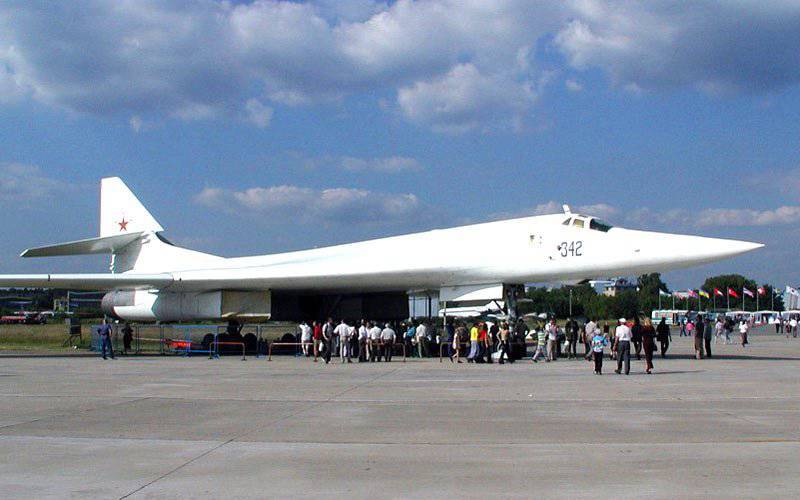
In February, B.N. Yeltsin 1992 announced a decree on the completion of the production of Tu-95MS bombers and the possibility of stopping the Tu-160 assembly, provided the United States stopped producing B-2 bombers (they were planning to build 100 units). However, this proposal did not meet an adequate response. In addition, with the collapse of the USSR, Russia was virtually left without new strategic bombers. This forced her to continue the release of such expensive aircraft, which began to enter into service with the 1096 regiment of heavy bombers in Engels. Officers from Priluk began to be transferred there (a total of 1992-93 in the years. The Russian Air Force filled up 720 pilots from Ukraine).
It should be noted that initially it was planned to transfer the first aircraft to Engels, the 184-th air regiment was considered as a backup, but life decided otherwise. Previously, the 1096 th TBAP was armed with bombers designed by V.Myasischev M-4 and 3М. Next to it was the 1230 th regiment of the 3MS-2 tanker aircraft. 16 February 1992 in Engels landed the first Tu-160, which had to be mothballed for six months - there was no one to fly. By May, the 1096 TBAP had already had three Tu-160, but the first flight took place only on July 29.
Inspector YES Lieutenant Colonel Medvedev lifted the car in the air. At the same time, the airfield was being refurbished - all ground equipment, flight simulators and aircraft preparation equipment remained in Priluky, and now everything had to be re-equipped.
The fourth machine arrived at Engels at the beginning of 1993. To strengthen the regiment of the "asset" veto, it was proposed to transfer six bombers of the Tupolev company and LII, even if they had time to develop a resource in test flights, but this did not happen. The first launch of the X-55 cruise missile was performed by 22 on October 1992 of the crew of the regimental commander Lieutenant Colonel A. Zhikharev. The next day, the same shooting training was conducted by the crew of Lieutenant Colonel A. Malyshev.
Despite all the difficulties, the DA of Russia managed to maintain a semblance of combat readiness. Even in the most difficult of 1992, the Russian "long-range" maintained classiness, having a raid of 80-90 hours a year - twice as high as in front-line aviation. As for the Tu-160, they took part in the large-scale exercises "Voskhod-93" in May 1993, during which the maneuver was worked out by the aviation forces with a quick response to the threat. The long range of the Tu-160 allowed them to strengthen one of the strategic directions and support the Su-24 and Su-27 group, which were deployed to the Far East (although the launch of the missiles had only to be indicated - there were no suitable ranges for them in Transbaikalia). A real launch, moreover, the modernized X-55M with an increased range, was made during the exercises of the Strategic Nuclear Forces on June 21-22, 1994, which were inspected by President Yeltsin. In addition to the Tu-160 group, successful launches at the Kura training ground in Kamchatka were made by the Topol ground complex and the North submarine cruiser fleet Type "Typhoon".
The position of the Tu-160 in the Russian Air Force seems to be not cloudy. The production of these machines in Kazan, after the transfer of five aircraft to the angel regiment, stalled (there were a total of eight machines at the plant in varying degrees of readiness). The economic difficulties of the Ministry of Defense were added to the economic troubles, the budget of which presupposes, above all, maintaining the combat capability of the current army and financing promising developments. The enormous costs absorbed by the mass production of the Tu-160, it seems more reasonable to send to work that meet the requirements of tomorrow and allow you to save the potential of "defense." One of the possible variants of the “seventies” could be a heavy fighter escort of the Tu-160P, armed with air-to-air missiles of a large and medium range. At the air show in Paris in 1991, the Tu-160SK was presented - a variant of civilian use of the aircraft. In this variant, it can be used as the first step of the Burlak aerospace complex developed at Raduga Scientific and Production Association (initially this military space program was aimed at replenishing the orbital constellation during the decommissioning of cosmodromes in Plesetsk and Baikonur). The launch vehicle is suspended under the fuselage and runs at an altitude of about 12 km, which makes it easier to make. The system will be able to put cargo weighing from 300 to 700 kg into near-earth orbit and is a response to the American Pegasus system.
In the Ukrainian army, aviators found themselves in an even more difficult situation, and, first of all, the problems affected the most complex and expensive to service DA aircraft. Immediately, it was necessary to abandon flights for combat use (Ukraine did not have polygons, and the equipment of the YA combat training center in the Dnieper-Buzhsky floods remained only on paper). Design supervision was stopped by the design bureau and support by the manufacturer, who for 10 years had to carry out warranty service. The lack of fuel, spare parts and the care of qualified flight and technical staff quickly put some of the planes on the joke. After all, the special engine oil IP-50 for Tu-160 was produced in Azerbaijan, the wheels were received from Yaroslavl, and the engines - from Samara. The development of resource aggregates and the lack of new forced to resort to "cannibalism", removing the required from other aircraft. However, recently the need for such events has almost disappeared - in the 184 TBAP by the summer of 1994 there were only a few pilots left who were able to lift the Tu-160 into the air. Unfortunately, this opportunity is given to them all 4-5 once a year. In full accordance with the theory of reliability, the reduced raid led to an increase in the number of failures, and the most difficult of them went to Gorgol: in May 1993, he had to land a plane with an undersized landing gear. As a result, the 5 of the Russian Tu-160 may represent a greater fighting force than the 21 located in Priluki.
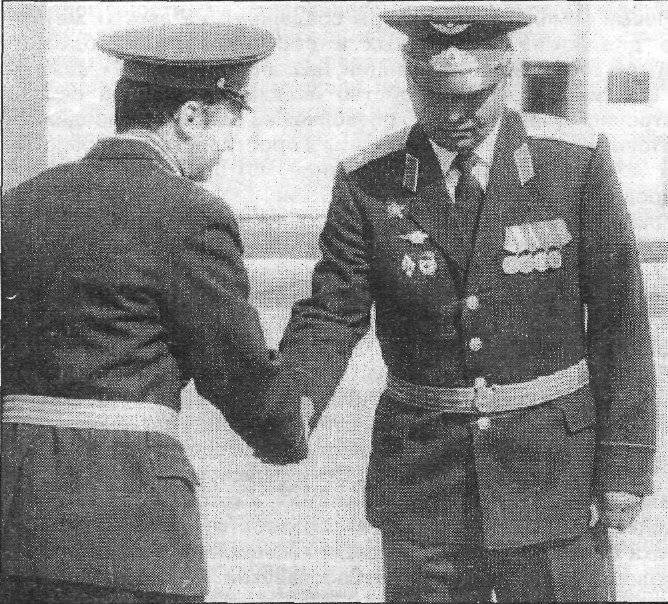
As a result of a number of hasty decisions taken in the first days after the collapse of the USSR, the right to possession of strategic forces was provided only for Russia. That deplorable situation in which Ukrainian Tu-160 found itself is a direct result of this policy. In March, 1993, Mr. V. Zakharchenko, the then adviser to the military attache of Ukraine in Russia, said: “There are no tasks for the Ukrainian armed forces that require such aircraft to be executed.” This opinion was confirmed by the commander of the Ukrainian Air Force, V. Antonetz, stating in a speech to journalists in Priluki 15 in February 1995 that the critical situation in the Ukrainian economy makes it impossible to maintain his Tu-160 in proper condition, therefore she is interested in selling Russian bombers. However, there were problems with the evaluation of machines. The Ukrainian side offered to write off energy debts at their expense (which surprised Gazprom a lot) or exchange them for IL-76 at the rate of 1: 2 (but Elah are produced in Uzbekistan ...). Until now, the parties have not agreed. Today, the fate of the Tu-160 completely depends on the political situation. But if you have goodwill, you can reach an agreement: for example, the Dnepropetrovsk plant “Yuzhmash” with 1994 resumed carrying out routine maintenance works on its missiles, which are on duty in Russia.
Brief technical description of the Tu-160
The Tu-160 is made according to the normal aerodynamic configuration with a variable sweep wing. The layout of the central part of the airframe is integral. The glider is made mainly of aluminum alloys (B-95, heat-treated to increase the resource, as well as AK-4). The share of titanium alloys in the mass of the airframe is 20%, composite materials are also widely used, glued three-layer structures are used.
The crew of four is located in the nose of the fuselage in the common pressurized cabin. Ahead - on the left - the commander of the ship, on the right - the second pilot. Behind them are placed the navigator's chairs (navigation and offensive weapons) and the navigator-operator (GKO system, communications and power engineering). All crew members have ejection seats K-36DM, shot up after dumping hatches. The cabin is equipped with a small kitchen and toilet. Entry aboard is carried out on the ground stairs through the niche of the front foot of the chassis (on the aircraft of the seventh series there is an integrated ladder).
Fuselage. In the forward part of the fuselage, semi-monocoque structures are located: the on-board radar, the equipment compartment with the avionics and air-conditioning units and the crew’s pressurized cabin, including the technical compartments, and the niche of the front chassis leg. Behind the cab are two successively placed weapon compartments of length 11,28 m and width 1,92 m. They contain one multiply charged turret ejection device MCU-6-5У, which can carry 6 X-55 missiles. The mass of the MCU is 1550 kg, the drive is hydraulic (on В-1В - from a stepping motor). In addition, locks can be installed in the weapon compartments for suspending the entire range of aviation weapons, weapons lifting systems, as well as electrocommutation equipment. On the end and side walls of the compartment there are hydraulic units. Between the compartments is the center beam. In the inset and tail parts of the aircraft fuel caisson tanks are located. In the nasal unsealed part of the influx are the units of the life support system.
The wing - swept with a root flow and swivel arms - has a large elongation. Knots of rotation of the consoles are located on 25% wing span with a minimum sweep. Structurally, the wing is divided into the following units:
- all-welded titanium beam center section 12,4 long m and 2,1 width m with a transverse set of ribs of aluminum alloy. The center-section beam is built into the central part of the airframe and ensures the perception of loads coming from the wing consoles;
- double-shear titanium turning units, ensuring the transfer of loads from the wing to the center section;
- wing consoles made of high-strength aluminum and titanium alloys, turning in the range of 20 ° - 65 °. During takeoff, the sweep angle of the consoles is 20 °, in the cruise flight mode it is -35 °, and during supersonic flight it is 65 °.
The power base of consoles is a caisson, formed by seven milled twenty-meter panels, five prefab spars and six ribs. Caisson serves as a tank for fuel. Four-section slats, three-section two-slot flaps, six-section interceptors and flaperons, and aerodynamic tips are attached directly to it.
With an increase in the angle of sweep of the wing, the root parts of the flaps do not retract into the fuselage, but in synchrony with the change of the sweep turn, forming peculiar aerodynamic ridges.
The tail tail is made according to the normal scheme with the all-rotary stabilizer located on the 1 / 3 height of the vertical tail (to take it out of the zone of influence of jet engines). Structurally, it consists of a caisson with nodes of rotation and honeycomb panels of aluminum or composite materials. The upper part of the keel is full turning.
The chassis has a steerable two-wheeled nose and two six-wheel main struts. Chassis track - mm 5400, base - mm 17800. The size of the main wheels - 1260x485 mm, nasal - 1080x400 mm. The nose rack is located under the technical compartment in an unpressurized niche and has a deflector that prevents foreign objects from getting from under the wheels into the air intakes of the engines. Rack retracts turn back on the flight.
Equipment. Radar "Obzor-K" in the nose of the fuselage is used for navigation and target detection both on the ground and in the air. Optical sighting system "Thunderstorm" is located at the bottom in the nose under the fairing. There is an astronavigation long-range navigation system. Instrumentation - classic analog. The airborne defense complex includes enemy detection and active radar counter systems. The control system is electroplating along the pitch, roll and yaw channels with fourfold redundancy and emergency mechanical wiring. The plane is statically unstable, so the flight with the disconnected electrical system is complex and has a number of restrictions on the modes. The aircraft’s hydraulic system is four-channel, with a working pressure of 280 kg / sq. All aircraft systems are controlled by about 100 computers, of which 12 maintains a weapon control system.
The power plant consists of four double-circuit turbojet engines NK-32, created in NPO Trud under the direction of N. D. Kuznetsov. The bypass ratio of the engine is 1,4, the degree of pressure increase is 28,4, and the maximum thrust is 137,3 kN (14000 kgf) without afterburner and 245,15 kN (25000 kgf) at the afterburner. The engine weight is 3650 kg, length - 6,5 m, inlet diameter - 1455 mm. The engine has a three-stage low-pressure compressor, a five-stage medium-pressure compressor and a seven-stage high-pressure compressor. Low and medium pressure turbines are single-stage, and high-two-stage turbines. Turbine blades - cooled monocrystalline. Gas temperature in front of the 1375 ° C turbine. The engine is equipped with an adjustable car nozzle. The combustion chamber is annular with evaporative nozzles, providing smokeless combustion and stable temperature conditions. NK-32 - one of the world's first aircraft engines, the development of which is widely used technology aimed at reducing levels of radar and infrared visibility. On the plane, the engines are located in engine nacelles in pairs, separated by firebreaks and operate completely independently of each other.
The engine management system is electric, with hydro-mechanical redundancy. Currently, work is underway to create a digital management system with full responsibility. To provide autonomous power supply, the gas turbine APU is installed on the plane behind the niche of the left pillar of the main landing gear.
The fuel is located in the 13 tanks in the fuselage and wing wing consoles. The fuel system includes an automatic fuel transfer to maintain the desired centering in all flight modes. The aircraft has a system for refueling in the air - the fuel rod extends from the nose.
Armament. The main weapon variant is 12 X-55 or X-55М / CM cruise missiles, according to 6 units on two MCU-6-5У devices.
The X-55 rocket (“125 product” or RKV-500B, under the NATO code AS-15b Kent, the M / CM index depends on the type of warhead) was developed at the Raduga Scientific and Production Association under the guidance of I. Seleznev. Has a length of 6040 mm, diameter 556 mm. To increase the flight range to 3000 km, the rocket can be equipped with dischargeable conformal fuel tanks. Starting mass of the rocket 1210 kg (without tanks) / 1500 kg (with tanks). The X-55CM is equipped with a 200 kT nuclear warhead.
An alternative weapon is the X-15 short-range missile (with inertial homing) and its variants: X-15С anti-ship and X-15П anti-radar. In total, the Tu-160 can take on the 24 missiles, six to four MKU-6-1 (two devices in each weapon compartment).
The X-15 rocket (the “115 product”, under the AS-16 Kickback NATO code) was also created at Raduga. Its length is 4780 mm, diameter is 455 mm, wingspan is 920 mm, weight is 1100 kg (warhead is 150 kg). Rocket flight speed M = 5. Range -150 km. With 24 rockets suspended, the mass of weapons is 28800 kg.
With appropriate re-equipment, the aircraft can carry free-fall nuclear bombs and any types of conventional bombs or sea mines.
Coloring aircraft. The prototype Tu-160, tested in LII, was not painted. It had a rather motley appearance due to the different colors and shades of cladding sheets and radio-transparent elements.
The airplanes transmitted in parts were painted in white color typical for USSR Long-Range Aviation, which, due to its reflectivity, is designed to protect the aircraft from the effects of light radiation in a nuclear explosion. Some elements, in particular, the upper engine nacelles and fairings along the tail fuselage have the color of unpainted metal.
Two-digit tactical numbers are applied to the wings of the nose gear and the top of the keel. Moreover, aircraft based in Priluki have red numbers, while in Engels they are blue.
Above and below on the wings and the keel were deposited red stars. In 1993, on the Ukrainian Tu-160, they were painted over, and for a while the cars did not have any signs of state ownership. Later, at the end of 1993 - the beginning of 1994. On the aircraft inflicted markings of the Ukrainian Air Force: yellow-blue circles on the wings and a yellow trident against the background of a blue shield on the keel. Russian Tu-160 bear identification marks inherited from the USSR Air Force.
Strategic bombers at Engels Air Base
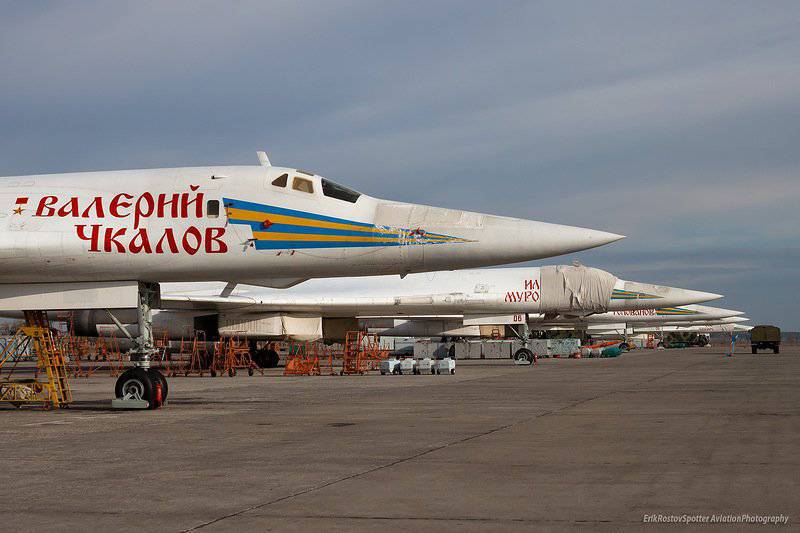
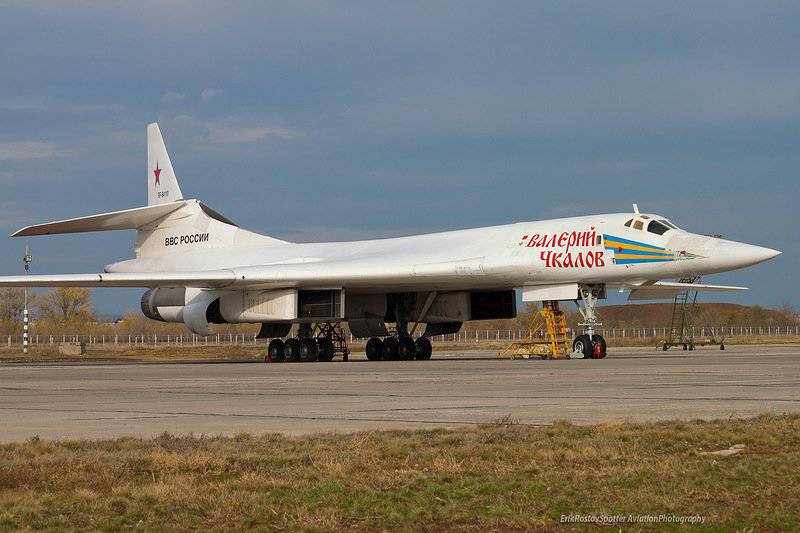
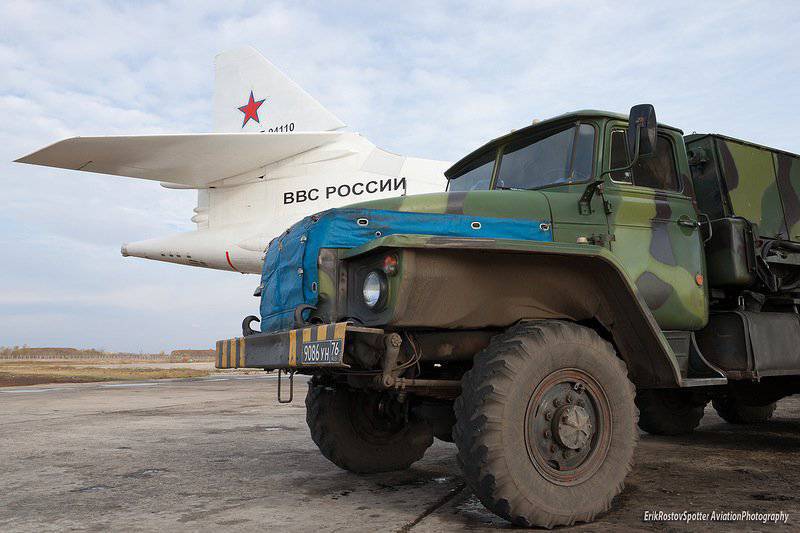
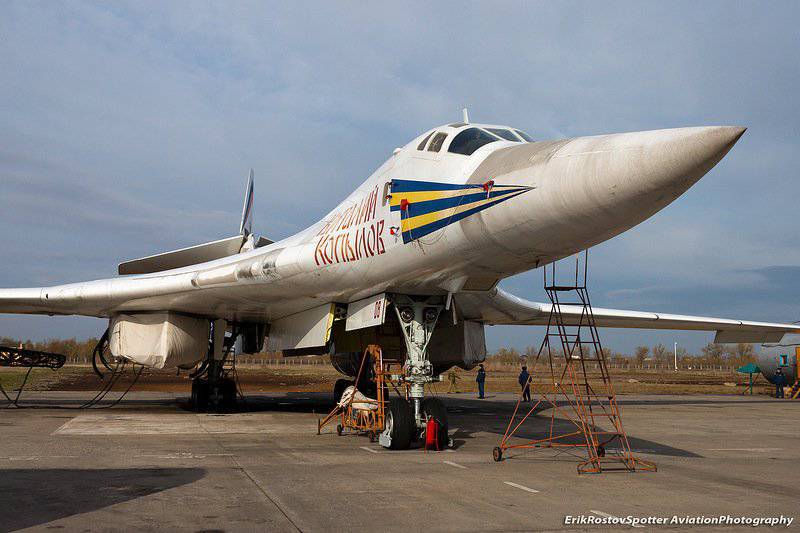
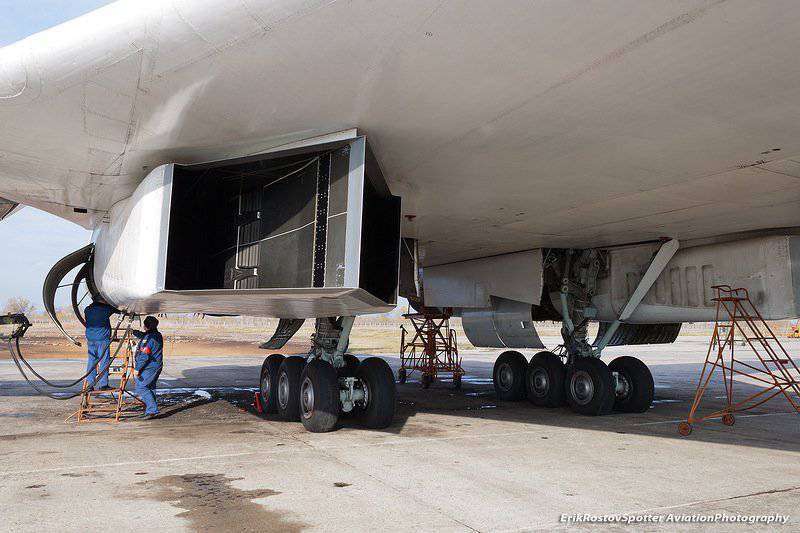

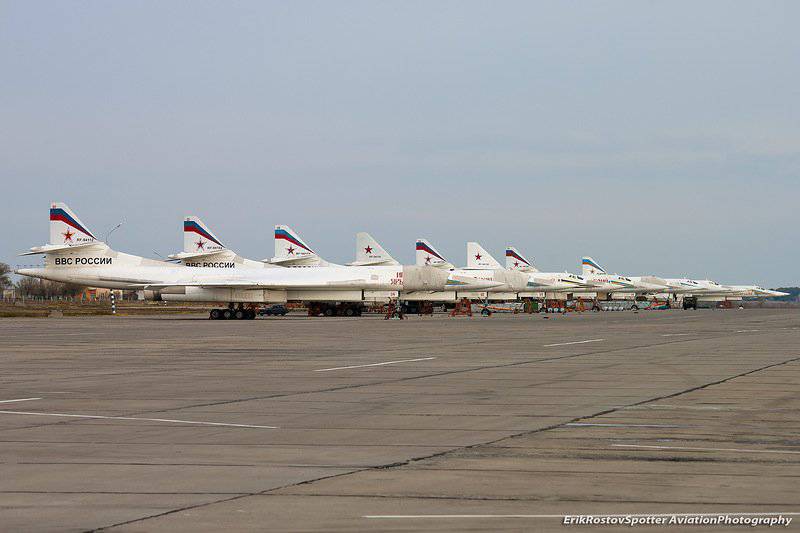
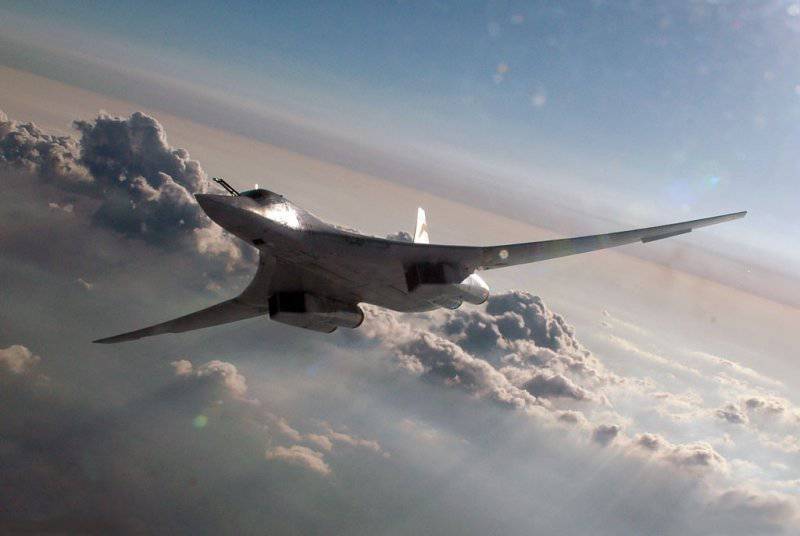
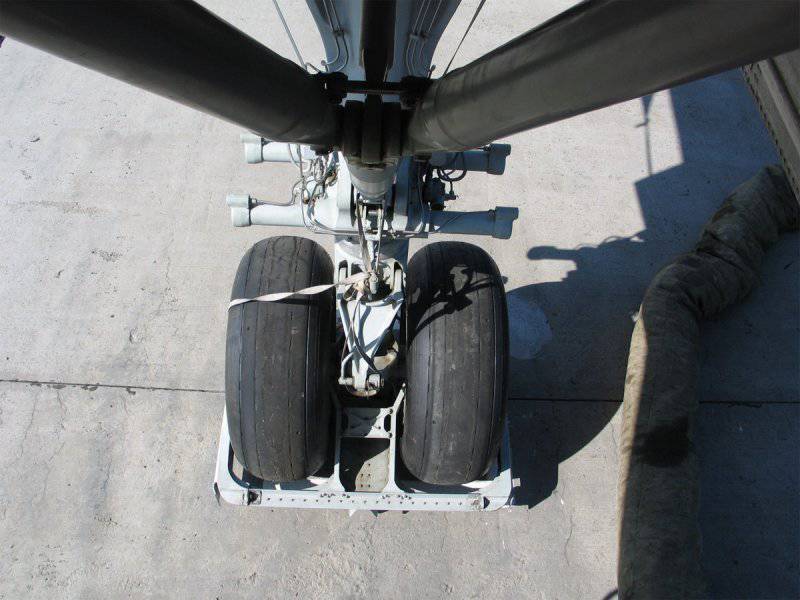
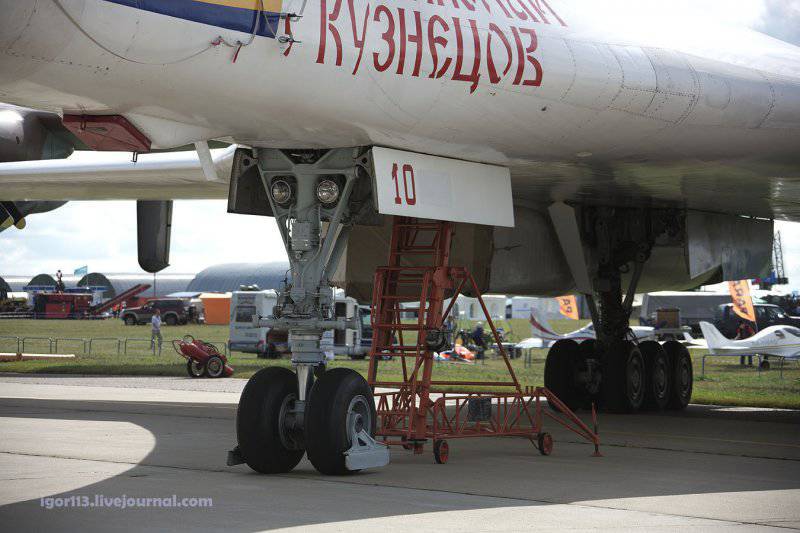
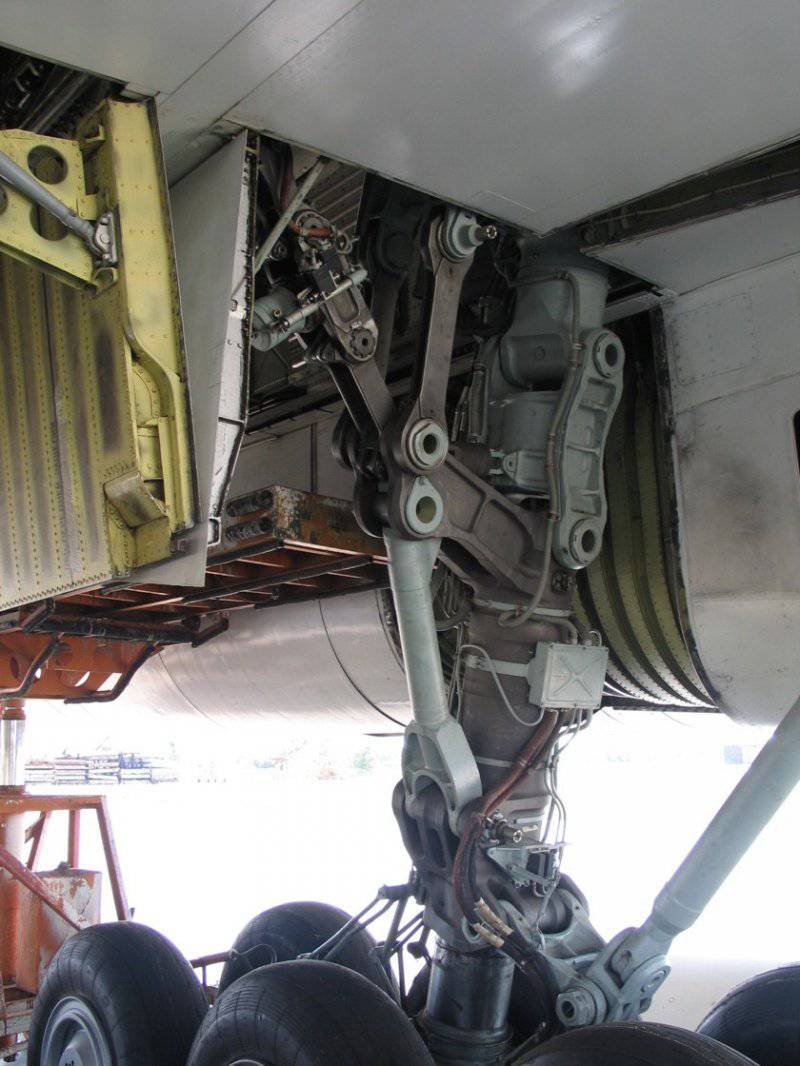
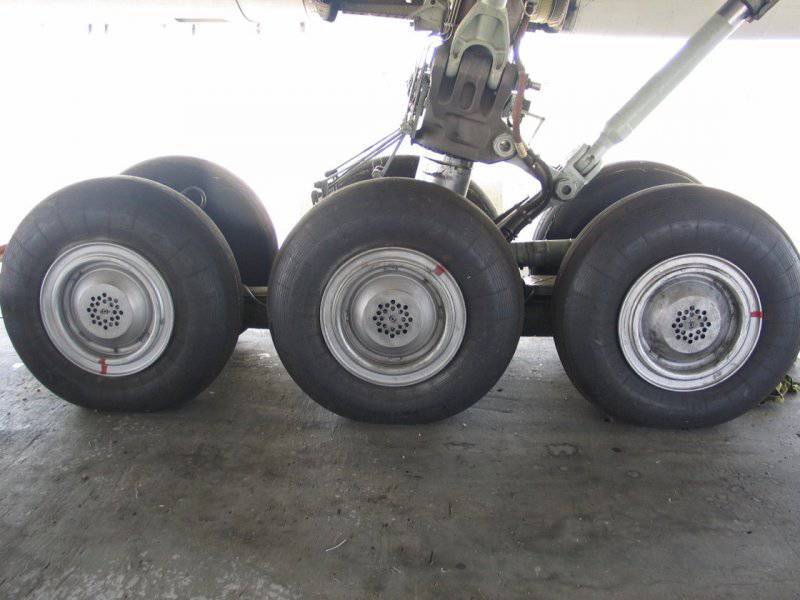
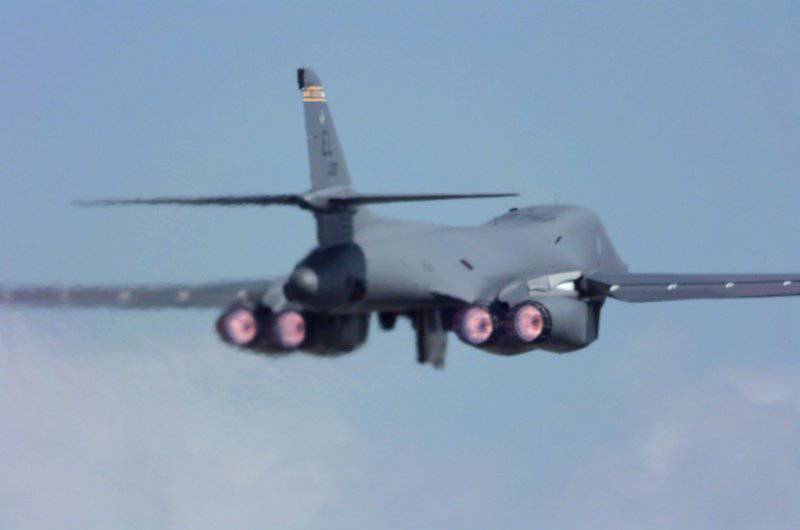
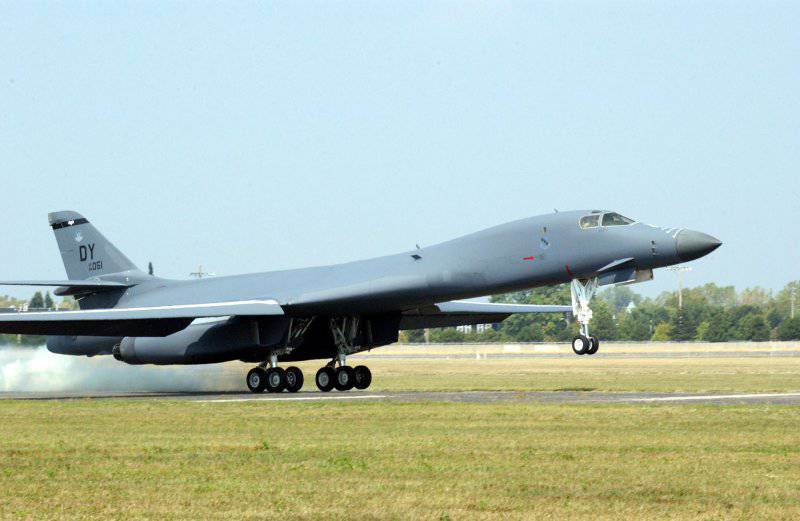
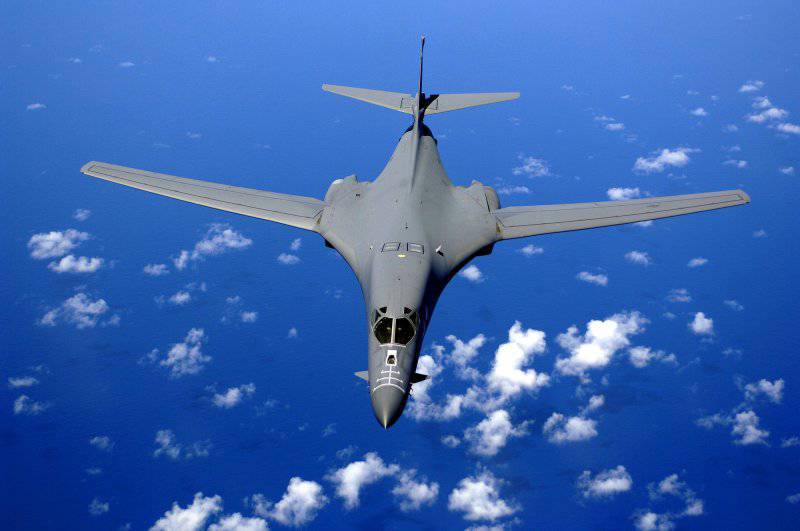
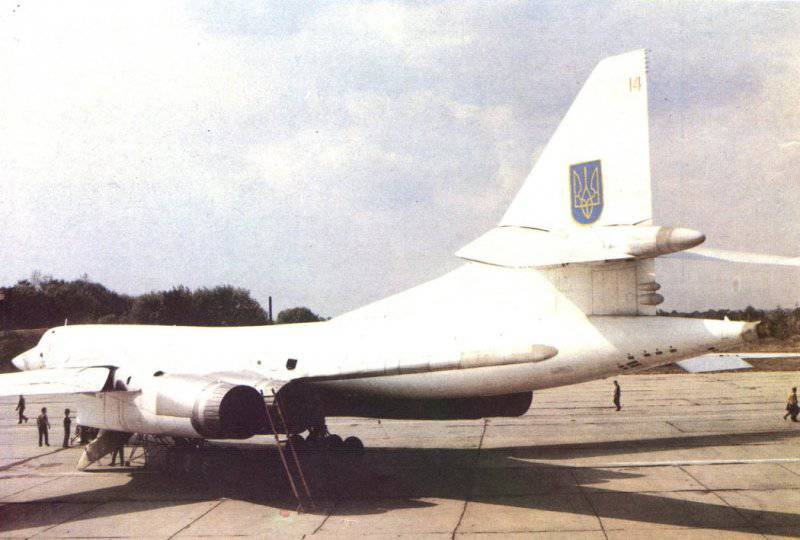
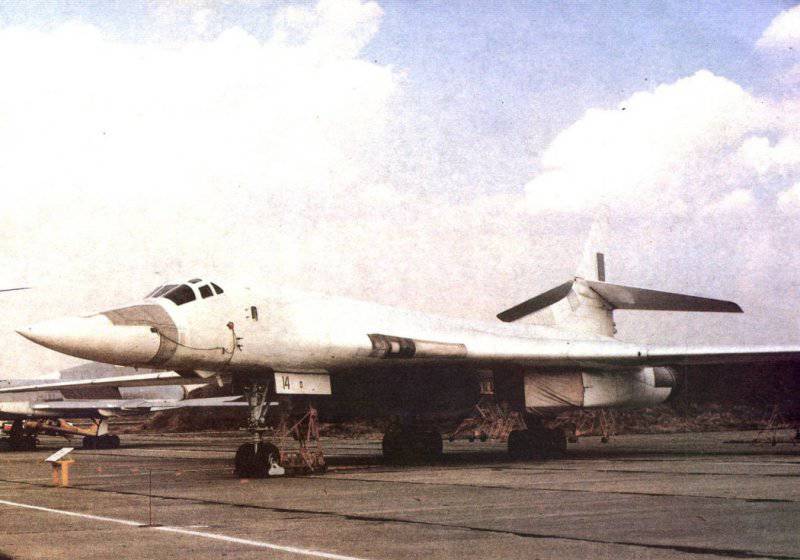
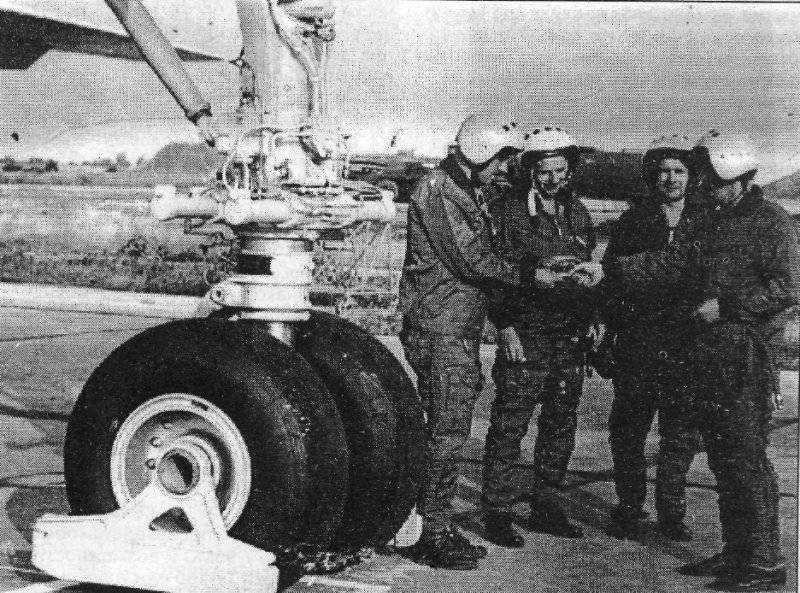
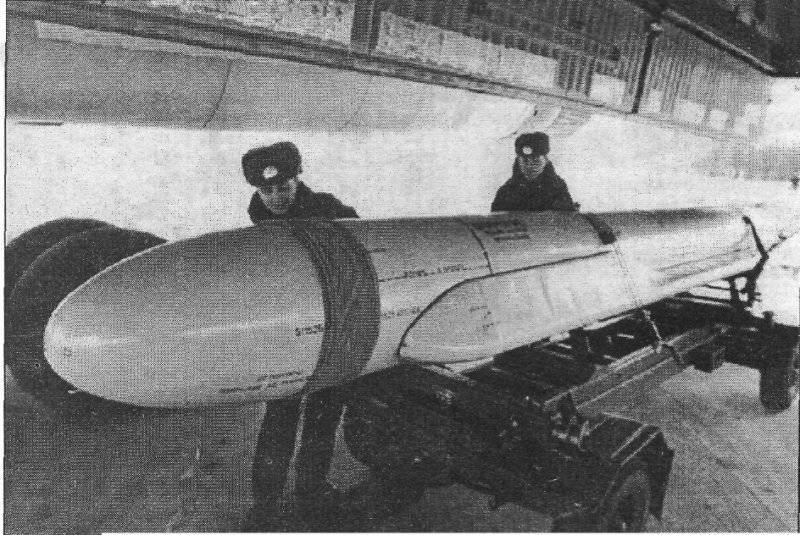
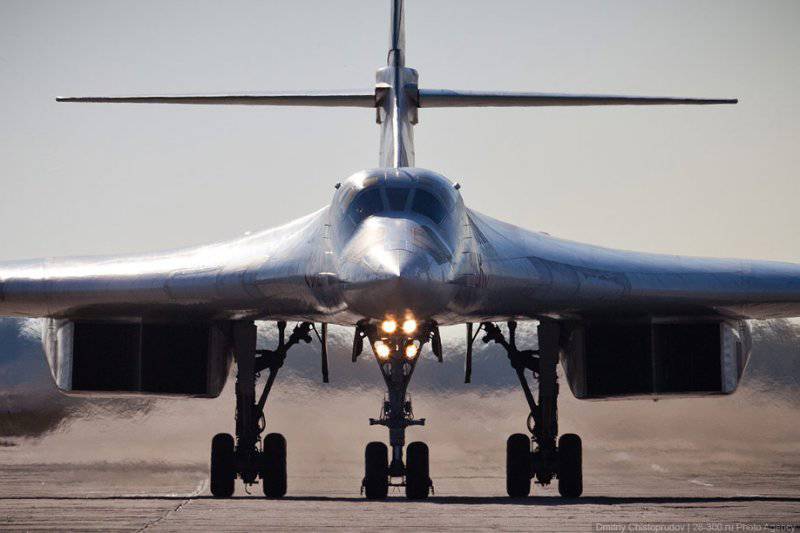
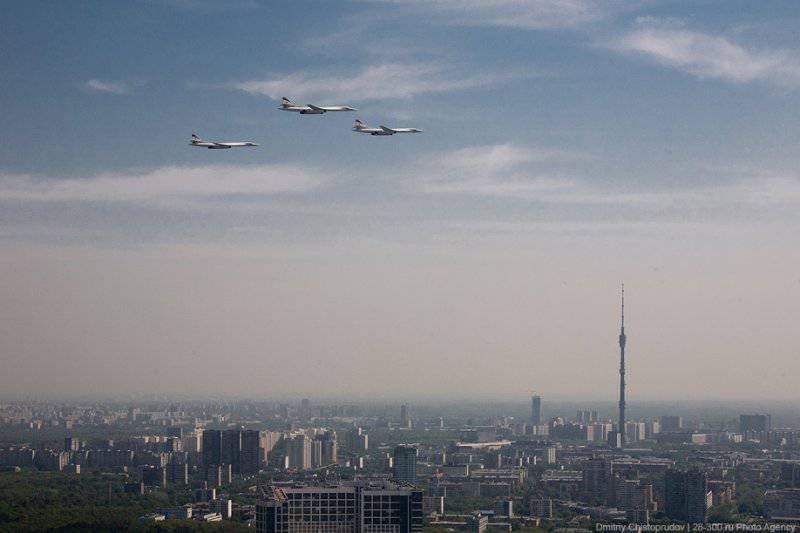
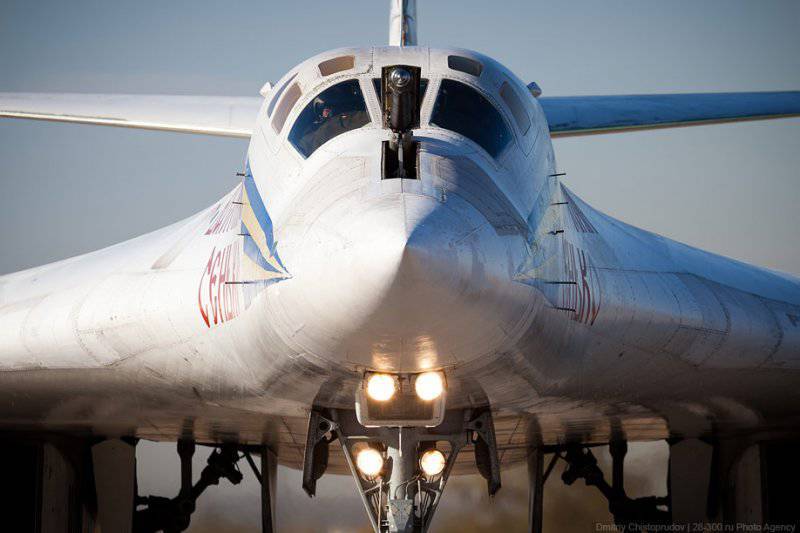
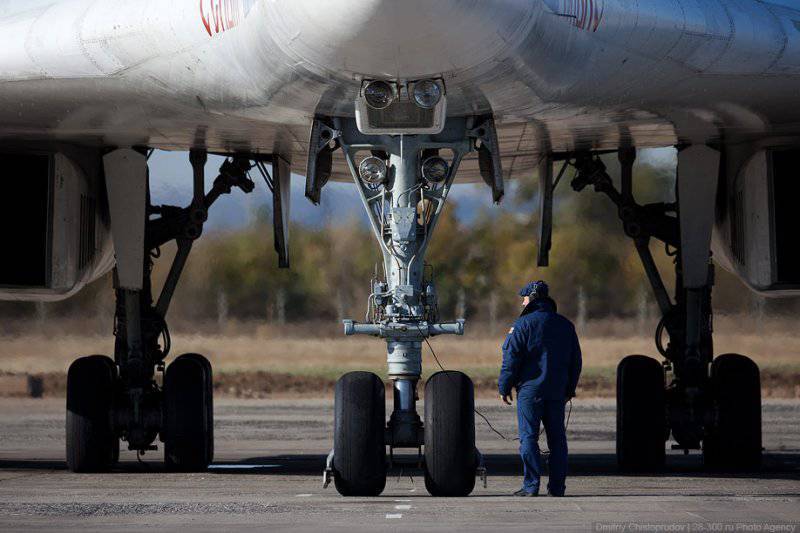
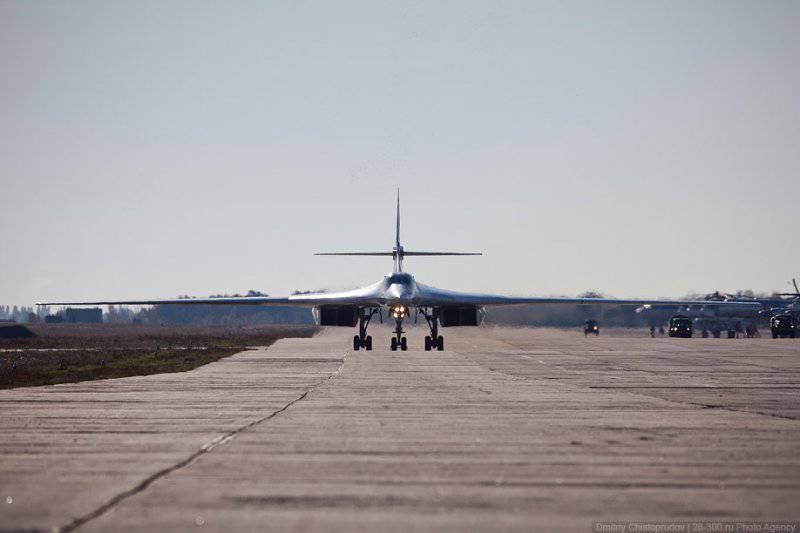
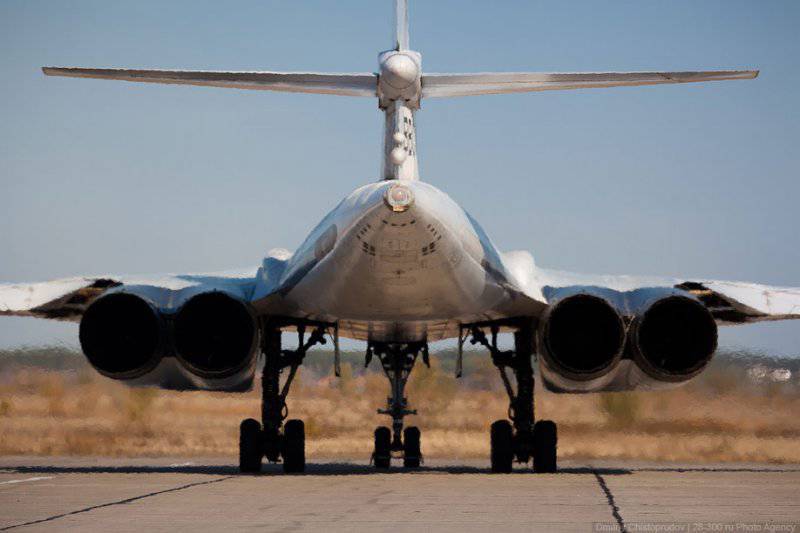
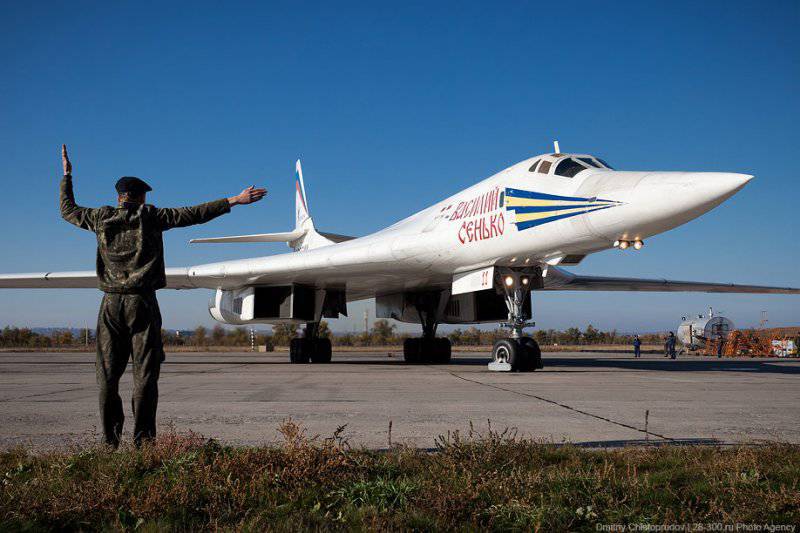
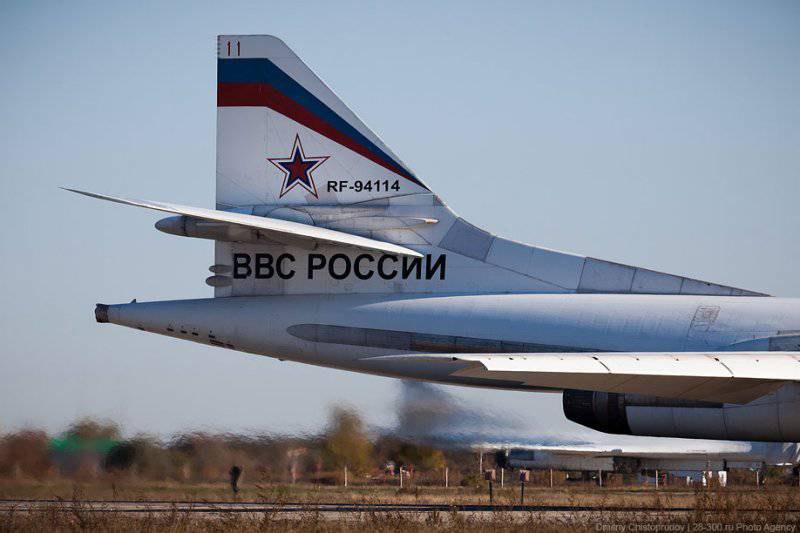
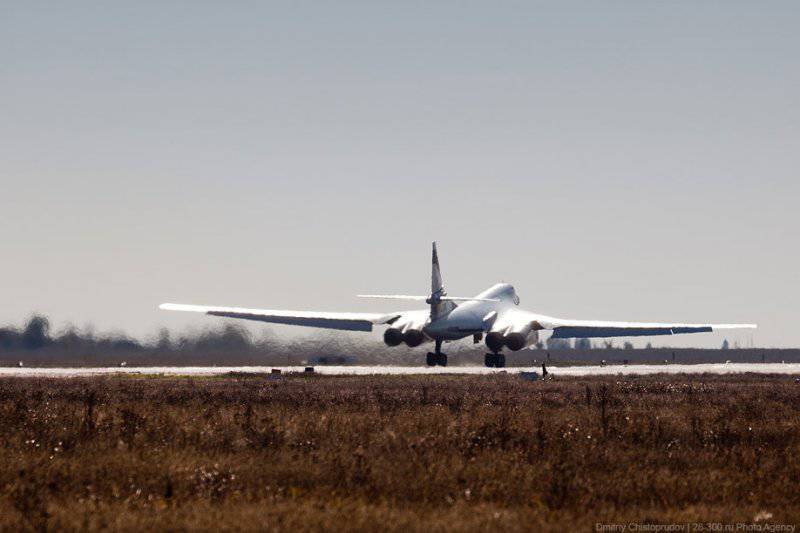
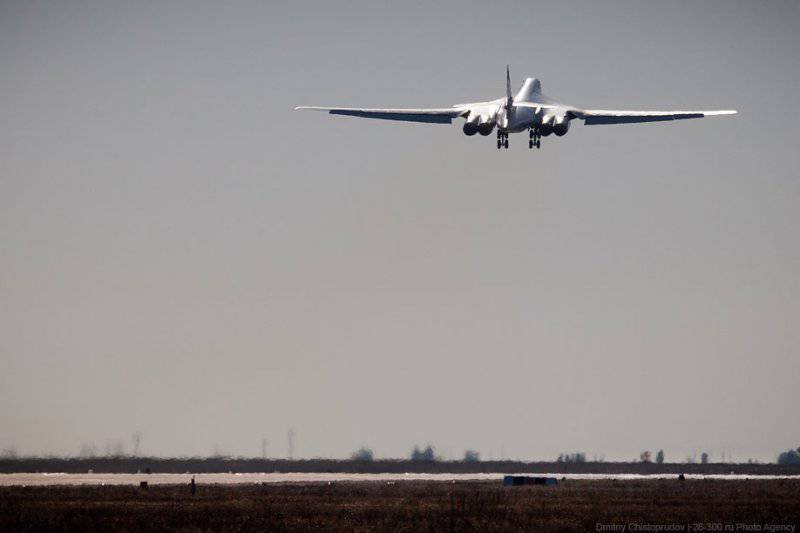
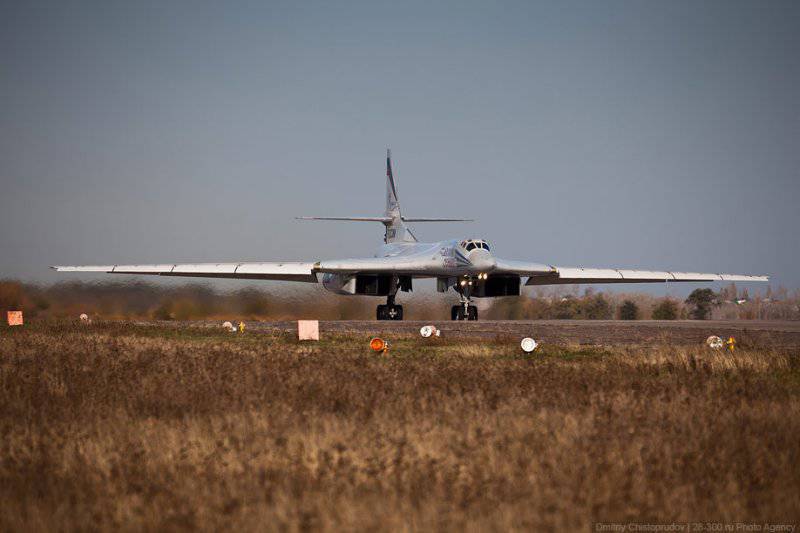
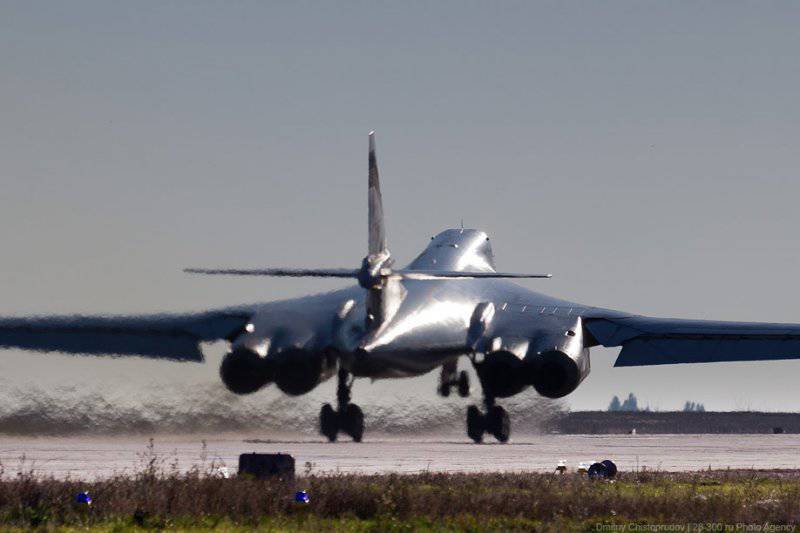
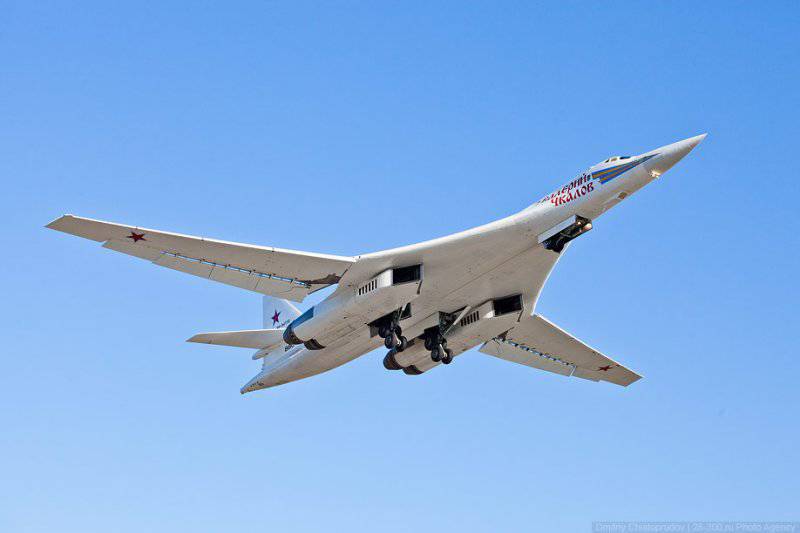
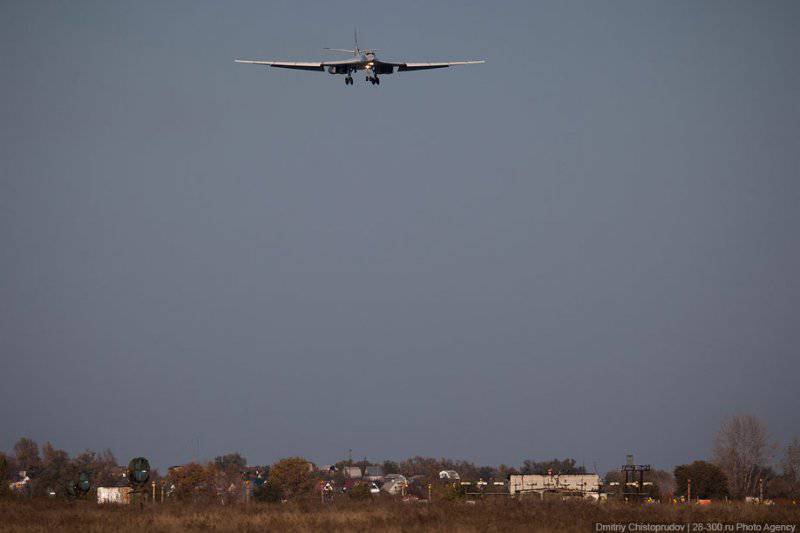
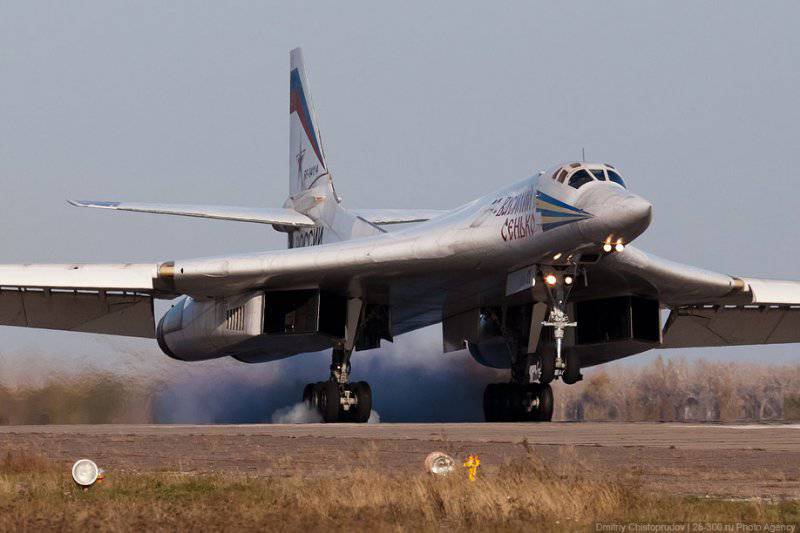
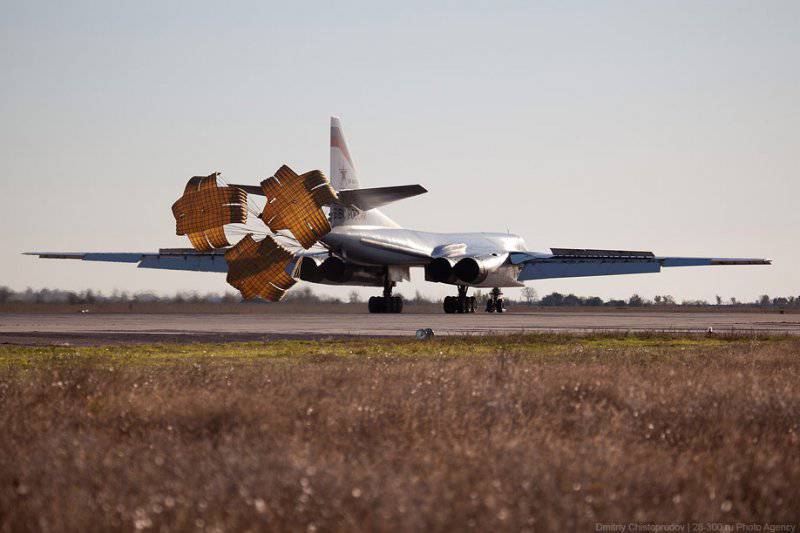
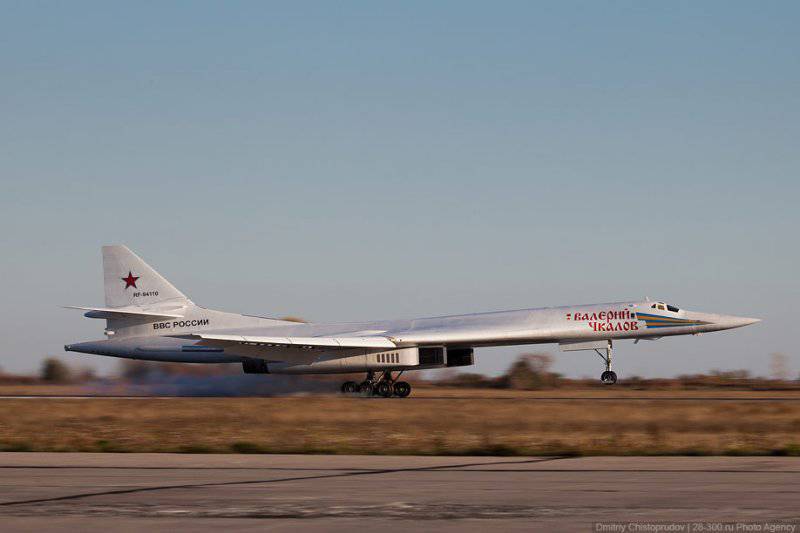
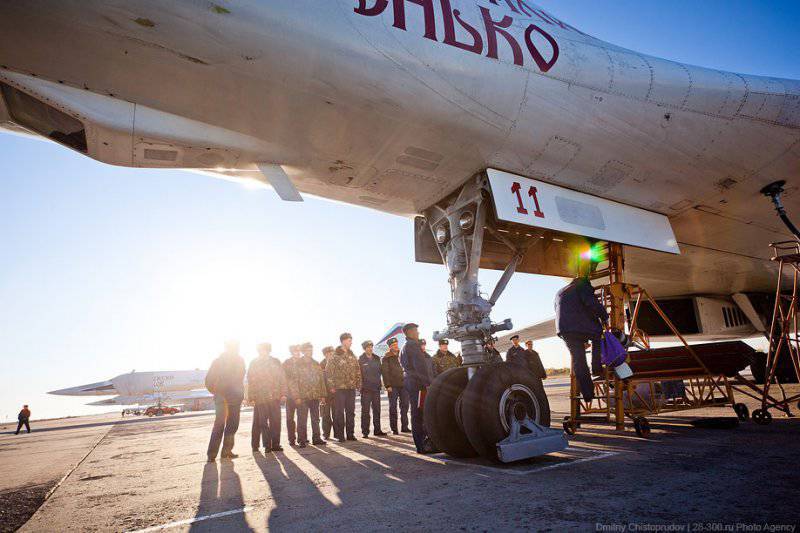
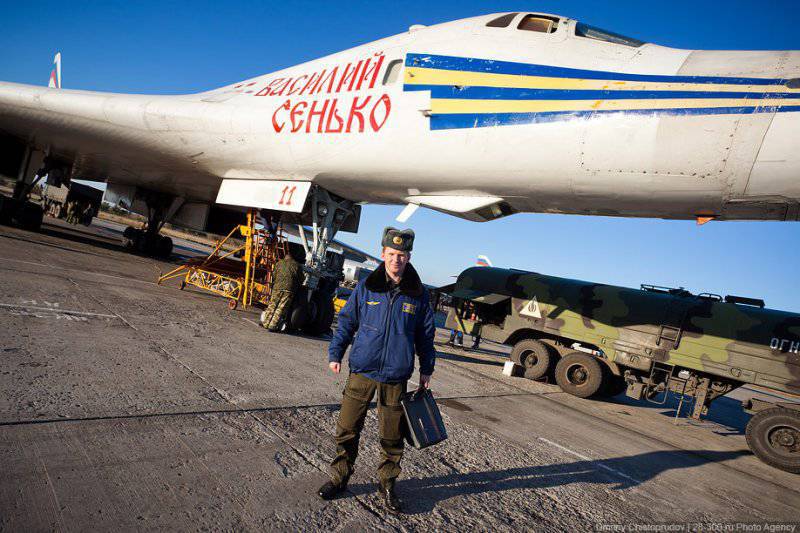
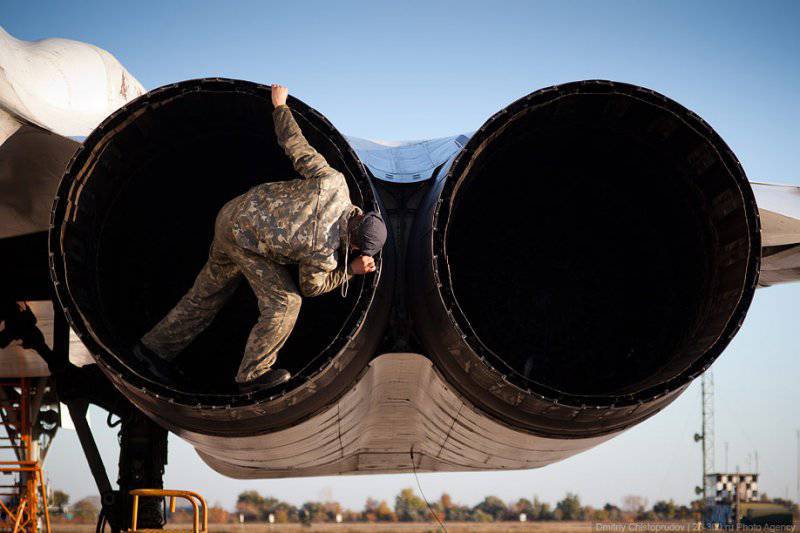
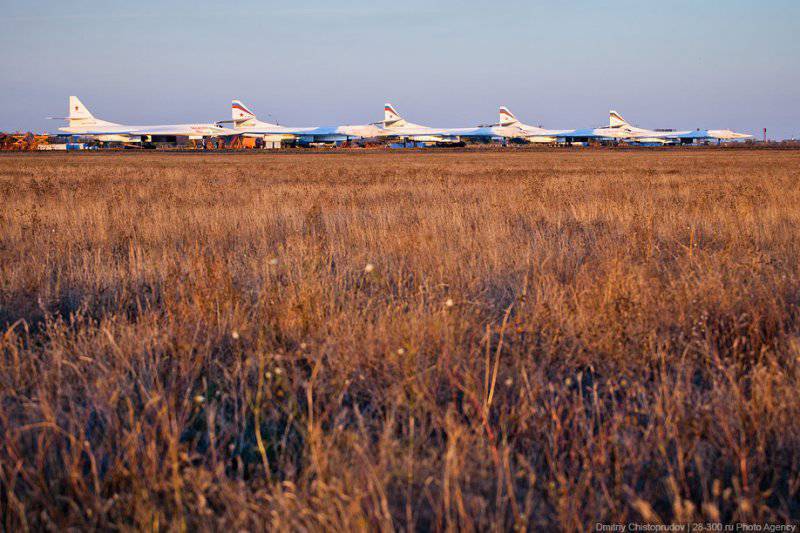
Information